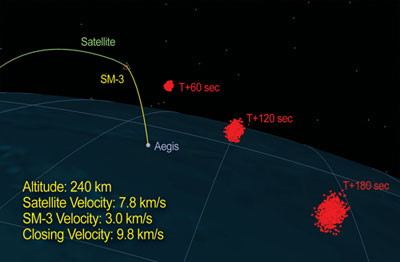Letter: The physics of reentering fuel tanksby Andrew Higgins
|
| Try heating a full tea kettle with an intense blowtorch. Until the water is boiled away, the skin of the kettle will remain at 100°C. |
If some hydrazine was vaporized locally, the fuel lines to the tank were believed to be ruptured due to aerodynamic disintegration of the satellite, allowing the hydrazine vapor to vent freely from the tank and preventing pressure from building up to a level where an explosion capable of completely destroying the tank was possible.
Yousaf Butt continues:
Quite separately, the vaporized hydrazine in the containment vessel contact layer will also exit from the shorn off fuel lines and there will be ignition at those locations also (due to both heat and plasma discharges), leading to a flash back to the main tank and its subsequent explosion as well. This is very similar to what is known to have taken place with the pyrovalves in Telstar 402 (September 8, 1994) and Landsat 6 (October 5, 1993).
This statement is also incorrect. It is extremely unlikely that an explosion could have occurred at the low pressures inside the hydrazine tank (which would have been much less than 1% atmospheric pressure until the tank was below 30 kilometers, and essentially vacuum above 50 kilometers, where aerodynamic heating is the most intense). If an explosion of the hydrazine vapor had occurred, the tank and the condensed hydrazine inside would have survived. Such tanks are rated to hold tens of atmospheres of pressure, while an explosion of hydrazine vapor at these pressures would not have exceeded an atmosphere of overpressure.
The Telstar 402 and Landsat 6 incidents (as well as the loss of Mars Observer) were associated with explosions occurring in pressurized hydrazine tanks that were already near their burst pressure. This is a very different situation than a tank that is venting to near-vacuum.
Finally, there is the issue of whether a vapor explosion in hydrazine could ignite or initiate the remaining liquid or frozen hydrazine in the tank. This is also extremely unlikely. The reason for this can be demonstrated with some more kitchen physics. You can run your finger through a candle flame for a second or two and feel essentially nothing. This is because the candle flame, while being at 1400°C, has very low density compared to your finger (which is about ten thousand times more dense than the gas in the candle flame), and therefore has very little ability to heat your finger in such a short time. The situation of a hydrazine vapor explosion at these low pressures (again, much less than an atmosphere) is similar. If the candle flame won’t burn your finger, a lower pressure hydrazine explosion in the tank won’t boil, much less ignite, the liquid hydrazine.
Indeed, experiments done in my laboratory at McGill University and elsewhere have shown that even detonating a mixture of hydrogen/oxygen on top of a very sensitive explosive is not usually able to ignite or initiate reaction in the liquid or solid explosive. The explosive, in fact, is not affected at all (although this is a demo I would not recommend trying in the kitchen). Hydrazine, by comparison, is a more stable substance (which is why it is used as a propellant) that has never been known to detonate in pure form.
In short, the hydrazine would not have be consumed by the mechanism Yousaf Butt described due to several error in his chain of reasoning, and the hydrazine very possibly would have made it to the ground.
| There is no reason to neglect doing the homework necessary to independently verify or refute the official scenario provided in justification of the intercept. |
That fact is that a dozen or so propellant tanks have survived reentry for orbit to hit the ground. A quick Internet search will reveal photographs of tanks found all over the world that have been positively identified as having originated from upper stages and satellites that have come down from orbit. Undoubtedly, many more have survived reentry to fall into the ocean or unpopulated area. These prior tanks were probably empty, and the fact that the USA 193 tank was reportedly full changes the considerations a bit—the heavier tank would have punched deeper into the atmosphere at higher speeds, increasing the heat loads it would see. However, the fact that propellant tanks do appear able to robustly survive reentry should be sobering to people who blithely discarded the possibility that the tank of USA 193 could have come down intact and still containing hydrazine.
Indeed, more than five years ago, NASA began to explore incorporating the requirement that hydrazine tanks “demise” upon reentry via a passive mechanism which would still function even in the case of a reentering dead satellite, which was exactly the case with USA 193. It is likely that this incident will renew interest in this topic.
Whether the risk the reentering USA 193 and its hydrazine tank was compatible with the expense and policy implications of the intercept is certainly a valid inquiry. Even when the risks are well quantified and carefully balanced, the ultimate motivation for the intercept of USA 193 may still be questioned. However, there is no reason to neglect doing the homework necessary to independently verify or refute the official scenario provided in justification of the intercept.
